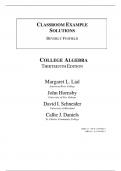Exam (elaborations)
Solution Manual For College Algebra, 13th Edition by Margaret L. Lial, John Hornsby, David I. Schneider, Callie J. Daniels
- Course
- Institution
Solution Manual For College Algebra, 13th Edition by Margaret L. Lial, John Hornsby, David I. Schneider, Callie J. Daniels
[Show more]



